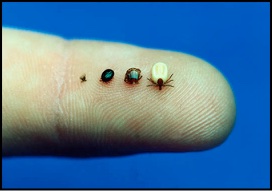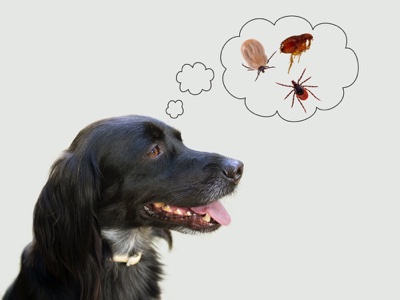Ben-Jee Kennels

Helping Your Dog Battle Fleas,
Ticks, and Worms
By M. Christine Zink from Dog Health & Nutrition For Dummies
Ticks
Ticks are major pests not only because they can bite your dog and cause local skin irritation, but because they carry a host of other pesky germs that can make both you and your dog sick. Ticks live on long grasses and shrubs, and they have a sticky substance on their bodies that enables them to easily cling to the fur of passing animals such as your dog. They then crawl down the hair to the skin and latch on, taking a big bite. They suck blood for hours and even days until they are full to bursting, as shown in the photo. During this time, they can transmit whatever infectious organisms they happen to be carrying.
If you live in an area where ticks are prevalent (most of the United States except the Southwest and Alaska), it is important that you check your dog for ticks every day, at least during tick season (which is during the spring and summer months). Carefully remove every tick you find.
If your dog enjoys the outdoors (and most dogs do), apply a product that prevents ticks from attaching to the skin. Be sure to get advice from your veterinarian on which product is best, because new products enter the market all the time. Also, continue to check your dog from head to toe every time he comes in from outside. The places you're most likely to find ticks are around your dog's face, eyes, and ears, although they really can be anywhere. Be sure to look inside the ears, too!
Fleas
Fleas are the bane of a dog's existence. They make him itch, itch, itch. And the more a dog scratches, the itchier he seems to get. These irritating insects can cause itching in two different ways. First, they bite on a big chunk of skin and start sucking blood. They stay at one spot until they are full, or hop around, drinking at many different sites. Worse, they often bite in thin-skinned, sensitive areas such as near the ears, at the base of the tail, and in the groin area. Flea bites are irritating enough, but many dogs actually develop an allergic reaction to the saliva of the fleas, and they become extremely itchy all over, even with the bite of only one flea. Sometimes the allergy is so severe that a dog will chew at himself until he loses big patches of hair, bleeds, and ultimately develops thick, crusty skin, especially on his feet, at the base of his tail, and around his back legs.
If you see your dog scratching vigorously or biting aggressively at himself, it's time for a bug check. Start by looking around your dog's ears, at the base of his tail, and on his tummy. Part the hair and look for brown, flat, oval bugs about 1/8 inch long. Keep your eyes peeled because a startled flea can jump quickly into the air and land several inches away. Frequently you won't actually see a flea, but you can see flea dirt stuck in the dog's hairs. This "dirt" is flea excrement, a crumbly black material that consists mainly of digested blood. You can identify flea dirt by placing a drop of water over the dirt, letting it soak up the water for a minute or two, and then smearing the dirt on a piece of white paper towel. A reddish smear confirms that it is, in fact, flea dirt.
If you identify a flea or flea dirt, leap into action. The only thing that will give your dog relief is ridding his body and your house of those pesky pests. With the many safe anti-flea products that are available today, there is no longer any reason for your dog to suffer.
Fleas are especially fond of cats, so if you share your digs with an animal of the feline persuasion, be sure to include her in your flea prevention and treatment protocol.
Worms
Dozens of kinds of worms can set up shop in your dog's body, often in the intestine. Puppies are especially susceptible to infections with worms, because some species of worms are transmitted from the mother before the puppy is even born. This is why deworming puppies is so important.
The general level of care for our dogs these days is so high, however, that adult dogs rarely have problems with worms. Nonetheless, it is a good idea to bring a fecal sample to your annual veterinary visit for the first few years of your dog's life, just to be sure.
If you adopt a dog from a shelter or find a stray, be sure to have him checked for worms, because you won't know whether he has had adequate veterinary care from puppyhood.
PET HELPERS
Good stuff to know
Photograph by Fred Dubbs. From right to left: An engorged adult deer tick, an adult before attaching to the skin, an engorged nymph (young tick), a nymph before it has attached. Both adults and nymphs can transmit Lyme disease.
Ticks are a year-round threat. However, many pet owners believe once the weather cools down, ticks go dormant and no longer pose a threat to their pets. Ticks can still attack in areas with mild winters. If your dog spends a good amount of time out in areas where long grass and brush are common, there is a very good chance your dog could pick up a tick or two. No need to panic though, as removing a tick is actually quite easy. With a few simple steps, you can have it out in no time.
Before You Begin
First off, do not agitate the tick by pouring alcohol on it, smothering it in petroleum jelly or putting a recently lit match on it. While these methods may cause the tick to pull its head out of the skin or even kill it, it will also regurgitate what it has already devoured, spreading bacteria into the open wound it created. The best method is to manually pull the tick out. Do this with great care as you must remove the head of the tick or it will cause the area to abscess.
Tick Removal Tools
Removal can be done in a couple of ways. There are tick-pulling products, such as a tick key or tick twister. These tick removal tools not only help you remove the head, but it prevents you from getting in contact with the tick. You could also use hemostats or gloved fingers to complete the extraction. Just be sure not to squish the tick while using these.
How to Remove Ticks From Dogs
Carefully pull the tick straight out of your dog’s skin. Avoid any twisting motion, as this can cause the tick’s head to break off. Once the tick is removed, place it in a container of rubbing alcohol. This will kill the tick in a short amount of time. Smashing the tick will also kill it, but be warned. Some ticks have very tough bodies and can be nearly impossible to squish. Washing the tick down the sink or flushing it down a toilet is not effective, as the tick may crawl back up the drain and wander through your house. You want to keep the dead tick in a plastic baggie for a few days in case your dog falls ill. The veterinarian can examine the tick for species identification and offer proper treatment for your dog.
Reward Your Dog
Disinfect the wound left behind from the tick’s bite with peroxide or an over-the-counter antiseptic. Then, treat Buster for being such a brave boy.
While dealing with ticks is never a pleasant experience, it is a common problem pet owners face. The more prepared you are to handle the situation when it arises, the better it will be for you and your dog—and the worse it will be for that pesky tick.
How to Safely Remove A Tick from Your Dog


NEW Hours:
Monday - Friday 8 am to 4:00 pm
Saturday 8 am to 3 pm
Sunday - Office closed except for pre-Paid Discharges by Appt.
Supervision: 24/7, 365 days a year
Fax: 215-257-3322
email: hallmark15@aol.com
47 Ridge Road, PO Box 1
Tylersport, PA 18971